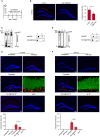Aβ oligomers trigger and accelerate Aβ seeding
- PMID: 31099449
- PMCID: PMC6916291
- DOI: 10.1111/bpa.12734
Aβ oligomers trigger and accelerate Aβ seeding
Abstract
Aggregation of amyloid-β (Aβ) that leads to the formation of plaques in Alzheimer's disease (AD) occurs through the stepwise formation of oligomers and fibrils. An earlier onset of aggregation is obtained upon intracerebral injection of Aβ-containing brain homogenate into human APP transgenic mice that follows a prion-like seeding mechanism. Immunoprecipitation of these brain extracts with anti-Aβ oligomer antibodies or passive immunization of the recipient animals abrogated the observed seeding activity, although induced Aβ deposition was still evident. Here, we establish that, together with Aβ monomers, Aβ oligomers trigger the initial phase of Aβ seeding and that the depletion of oligomeric Aβ delays the aggregation process, leading to a transient reduction of seed-induced Aβ deposits. This work extends the current knowledge about the role of Aβ oligomers beyond its cytotoxic nature by pointing to a role in the initiation of Aβ aggregation in vivo. We conclude that Aβ oligomers are important for the early initiation phase of the seeding process.
Keywords: Alzheimer's disease; Aβ oligomers; Aβ seeding; amyloid-β plaques.
© 2019 The Authors. Brain Pathology published by John Wiley & Sons Ltd on behalf of International Society of Neuropathology.
Figures




References
-
- Bachhuber T, Katzmarski N, McCarter JF, Loreth D, Tahirovic S, Kamp F et al (2015) Inhibition of amyloid‐beta plaque formation by alpha‐synuclein. Nat Med 21:802–807. - PubMed
-
- DeMattos RB, Bales KR, Parsadanian M, O'Dell MA, Foss EM, Paul SM, Holtzman DM (2002) Plaque‐associated disruption of CSF and plasma amyloid‐beta (Abeta) equilibrium in a mouse model of Alzheimer's disease. J Neurochem 81:229–236. - PubMed
Publication types
MeSH terms
Substances
LinkOut - more resources
Full Text Sources

